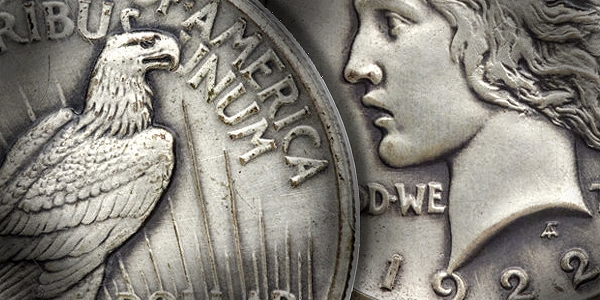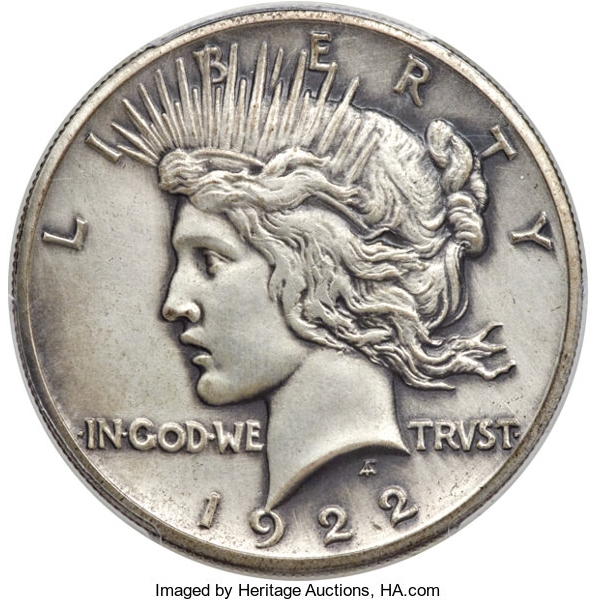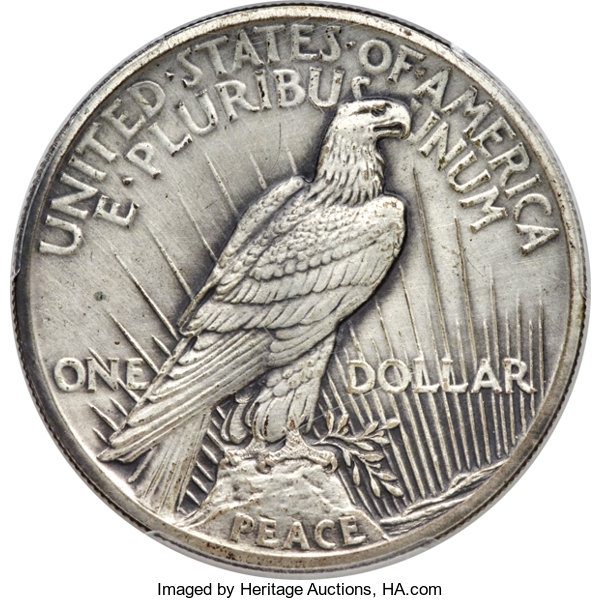
Judd-2018 is a recently discovered trial striking of the 1922 High Relief Peace dollar, struck in business-strike format and first reported by David W. Lange in 2007. It is one of the rarest die combinations from 1921 to 1922, a time period when the Mint experimented extensively with the relief of Anthony de Francisci’s artistic Peace dollar design, in sandblast, satin, proof, and business-strike finishes. Judd-2018 combines George T. Morgan’s slightly reworked 1922 High Relief obverse, which was later used to strike the 1922 High Relief proof issues, with the old reverse design used on the 1921 Peace dollars (which were struck in high relief), with a possibly unique sandblasted antique finish.

Only three examples of Judd-2018 have been identified.
Heritage Auctions is privileged to offer the finest-known example of this rare pattern issue, from the estate of Mint Director Raymond T. Baker, in this important offering as a part of the January 9-14 FUN Signature Auction.
High relief 1922 Peace dollars have been known to specialists since the 1920s, when Farran Zerbe exhibited a proof example in his “Money of the World” Collection, but no business-strike examples were identified until recent times.
In 1974, researcher R.W. Julian found documentation in the General Services Administration in Philadelphia that revealed a previously unknown trial mintage of 35,401 business-strike 1922 High Relief Peace dollars that took place between January 5 and January 23, 1922. Reportedly, four obverse and nine reverse dies were used to accomplish the small trial mintage. The coins were struck on regular-production toggle coin presses, not the medal press. The high relief of the design required extremely high striking pressure to bring up the details of the devices, resulting in an unacceptable rate of die failure. All these trial strikes were believed to be destroyed, but it seems a few were sent to Mint and Treasury officials in Washington, D.C. for inspection, escaping the wholesale melting of the rest of the mintage. All three Judd-2018 survivors were apparently struck from the same die pair, suggesting they were all struck and sent out at about the same time, but more study is needed to confirm this.

Julian reported his findings to Q. David Bowers in 1993, and they discussed a single VF example of the 1922 High Relief Peace dollar known to them that had a non-proof finish – a possible survivor from the mysterious 1922 trial striking. After further experimentation with a 1922 Medium Relief Peace dollar issue, Mint officials determined only a low-relief Peace dollar design could satisfy the requirements of high-speed business-strike coinage. Most of the experimental trial pieces were melted for recoinage shortly afterward.
In 2007, numismatist David Lange examined a 1922 High Relief Peace dollar found in an otherwise unremarkable collection of silver dollars. Lange noticed the reverse design was slightly different from that used on the high relief proof issues of that year and determined the coin represented a previously unknown variety. The discovery coin made its debut auction appearance in lot 8545 of Stack’s January 2008 Americana sale, incorrectly designated a satin proof by NGC, as the new research on Judd-2018 was not widely available at the time.
This same coin appeared in two later Stack’s auctions in 2008 and 2009.
Next, the coin offered here surfaced in a Goldbergs auction in 2014. More recently, a circulated, heavily polished example designated Specimen, VF Details appeared in lot 4578 of Heritage’s August 2015 ANA Signature.
Naturally, one wonders if the Heritage coin is the same example Julian and Bowers referred to in the 1990s. No other specimens have been discovered.
We believe this coin, from the estate of Mint Director Raymond T. Baker, was sandblasted and treated with an antique charcoal finish to accent the fine details of the design. A specimen of the 1921 High Relief Peace dollar, also from Baker’s estate, was offered in a Stack’s Bowers auction in 2014. That coin features the same antique finish as this piece, a finish that is unique to these two specimens in the entire Peace dollar series.
The design elements of this coin are noticeably sharper than expected from a High Relief business-strike issue, if not quite as full as those on the 1922 High Relief proofs. Just a touch of softness shows on Liberty’s hair and the eagle’s feathers in the centers. The rims are slightly reduced and the diagnostic short ray through the N in ONE is boldly rendered. The devices have a three-dimensional sculptural quality. The basined surfaces are well-preserved consistent with the SP64 grade assigned by PCGS, with a few minor ticks in the hair the only marks of note. The antique charcoal finish was partially brushed off at the Mint, leaving an outline of amber patina around all the design elements. The overall presentation is most attractive.
As the finest-known example of this extremely rare pattern issue, and the only one with the unique antique finish, this offering represents an especially important opportunity for pattern collectors and Peace dollar specialists.





Căn someone tell me what I nd to do I have come across a E F 1922 peace dollar uncirculated no mint is it worth hitting checked out
I believe that I may have located a 1921 peace silver dollar high relief specimen, sand blasted and antiqued..! Can we have the coin verified, locally before sending it to be graded, how would we be able to insure the coin throughout transport and grading process, how do we insure and protect the coin until it returns back to us..? Most people don’t want to let the coins out of their sight, since it cannot be replaced? We have tried to contact the agencies and no one is taking us serious, they think that we are lying..! They are trying to tell me that its juts highly patina and oxidation..?
I have two 1921 silver dollars with the mint with the mint cold 00990. I think it is D actually is D on the back of them and I also have a 1821 Silver dollar could you tell me what the value of those corns is I will send you a picture of them